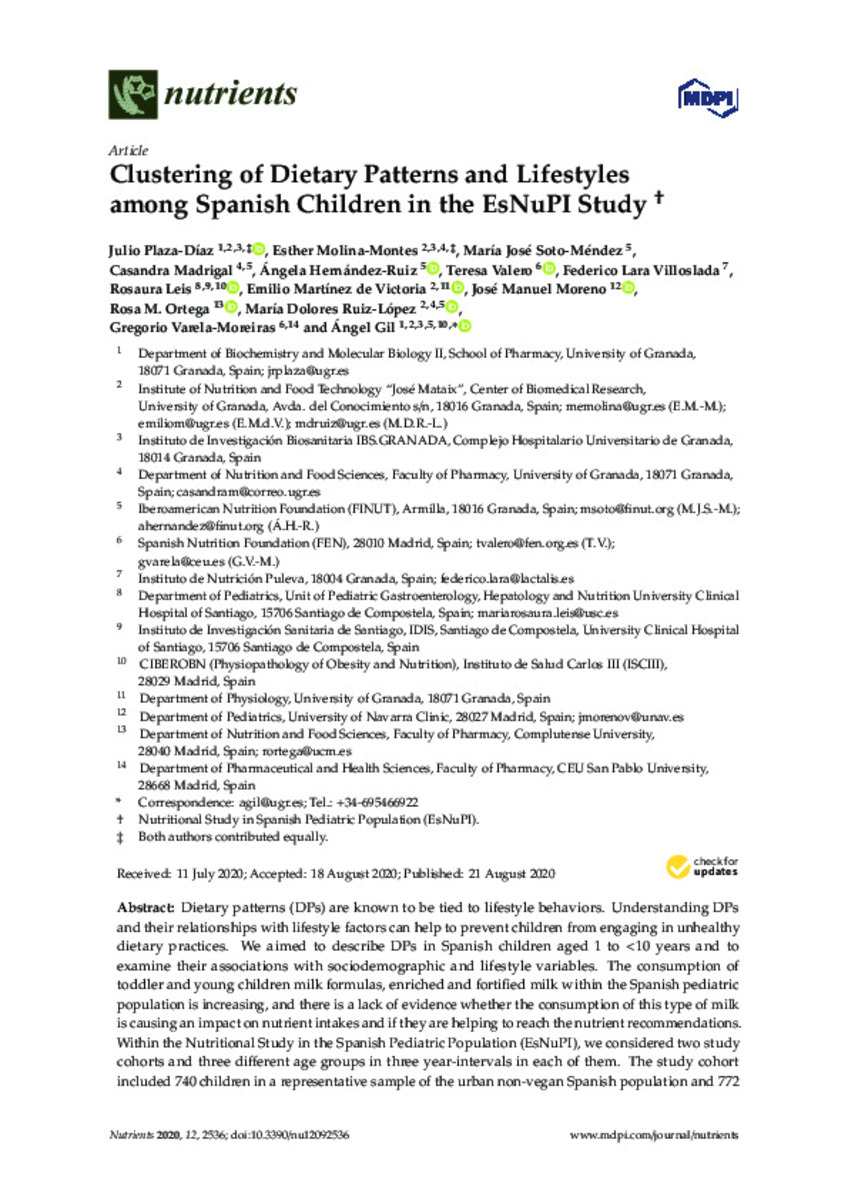Full metadata record
| DC Field | Value | Language |
|---|---|---|
| dc.creator | Plaza-Díaz, J. (Julio) | - |
| dc.creator | Molina-Montes, E. (Esther) | - |
| dc.creator | Soto-Méndez, M.J. (María José) | - |
| dc.creator | Madrigal, C. (Casandra) | - |
| dc.creator | Hernández-Ruiz, Á, (Ángela) | - |
| dc.creator | Lara-Villoslada, F. (Federico) | - |
| dc.creator | Leis, R. (Rosaura) | - |
| dc.creator | Martínez-de-Victoria, E. (Emilio) | - |
| dc.creator | Moreno, J.M. (José Manuel) | - |
| dc.creator | Varela-Moreiras, G. (Gregorio) | - |
| dc.creator | Gil, A. (Ángel) | - |
| dc.date.accessioned | 2023-03-23T08:49:24Z | - |
| dc.date.available | 2023-03-23T08:49:24Z | - |
| dc.date.issued | 2020 | - |
| dc.identifier.citation | Plaza-Díaz, J. (Julio); Molina-Montes, E. (Esther); Soto-Méndez, M.J. (María José); et al. "Clustering of Dietary Patterns and Lifestyles among Spanish Children in the EsNuPI Study". Nutrients. 12 (9), 2020, | es |
| dc.identifier.uri | https://hdl.handle.net/10171/65769 | - |
| dc.description.abstract | Dietary patterns (DPs) are known to be tied to lifestyle behaviors. Understanding DPs and their relationships with lifestyle factors can help to prevent children from engaging in unhealthy dietary practices. We aimed to describe DPs in Spanish children aged 1 to <10 years and to examine their associations with sociodemographic and lifestyle variables. The consumption of toddler and young children milk formulas, enriched and fortified milk within the Spanish pediatric population is increasing, and there is a lack of evidence whether the consumption of this type of milk is causing an impact on nutrient intakes and if they are helping to reach the nutrient recommendations. Within the Nutritional Study in the Spanish Pediatric Population (EsNuPI), we considered two study cohorts and three different age groups in three year-intervals in each of them. The study cohort included 740 children in a representative sample of the urban non-vegan Spanish population and 772 children in a convenience cohort of adapted milk consumers (AMS) (including follow-on formula, toddler’s milk, growing up milk, and fortified and enriched milks) who provided information about sociodemographics, lifestyle, and dietary habits; a food frequency questionnaire was used for the latter. Principal component analysis was performed to identify DPs from 18 food groups. Food groups and sociodemographic/lifestyle variables were combined through a hierarchical cluster algorithm. Three DPs predominated in every age group and study sample: a palatable energy-dense food dietary pattern, and two Mediterranean-like DPs. However, children from the AMS showed a predominant dietary pattern markedly related to the Mediterranean diet, with high consumption of cereals, fruits and vegetables, as well as milk and dairy products. The age of children and certain lifestyle factors, namely level of physical activity, parental education, and household income, correlated closely with the dietary clusters. Thus, the findings provide insight into designing lifestyle interventions that could reverse the appearance of unhealthy DPs in the Spanish child population. | es_ES |
| dc.description.sponsorship | This research was funded by Instituto Puleva de Nutrición (IPN).The authors would like to thank IPN for its support and technical advice. The results presented in this article constitute part of Casandra Madrigal Arellano’s doctoral thesis, performed in the Nutrition and Food Sciences Doctorate Program of the University of Granada and financed by Consejo Nacional de Ciencia y Tecnología (CONACYT). | es_ES |
| dc.language.iso | eng | es_ES |
| dc.rights | info:eu-repo/semantics/openAccess | es_ES |
| dc.subject | Children | es_ES |
| dc.subject | Cluster analysis | es_ES |
| dc.subject | Dietary patterns | es_ES |
| dc.subject | Physical activity | es_ES |
| dc.subject | Sedentary behavior | es_ES |
| dc.title | Clustering of Dietary Patterns and Lifestyles among Spanish Children in the EsNuPI Study | es_ES |
| dc.type | info:eu-repo/semantics/article | es_ES |
| dc.description.note | This article is an open access article distributed under the terms and conditions of the Creative Commons Attribution (CC BY) license (http://creativecommons.org/licenses/by/4.0/). | es_ES |
| dc.identifier.doi | 10.3390/nu12092536 | - |
| dadun.citation.number | 9 | es_ES |
| dadun.citation.publicationName | Nutrients | es_ES |
| dadun.citation.volume | 12 | es_ES |
Files in This Item:
Statistics and impact
Items in Dadun are protected by copyright, with all rights reserved, unless otherwise indicated.






